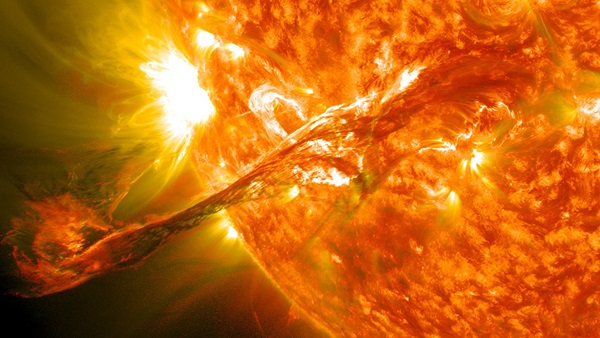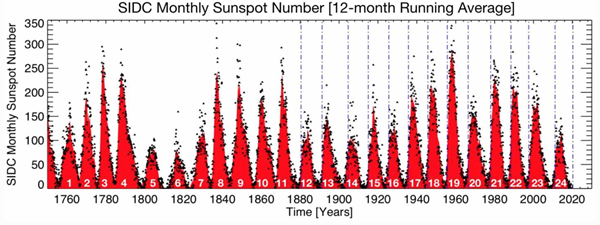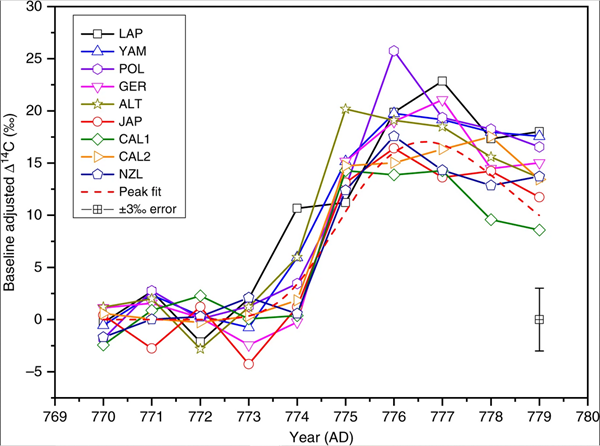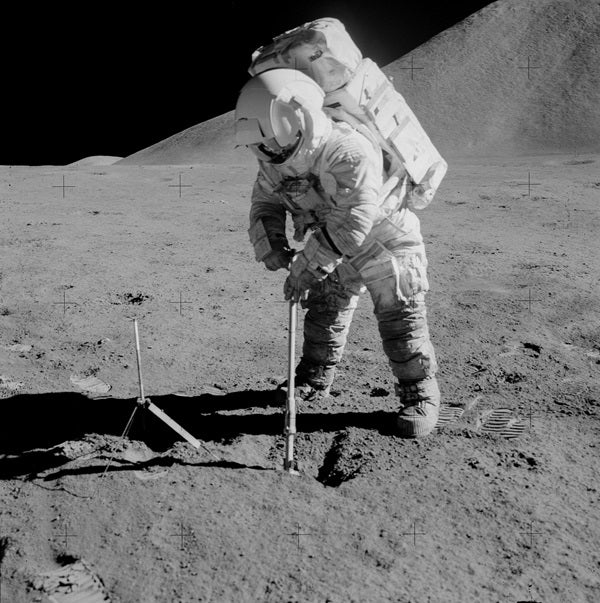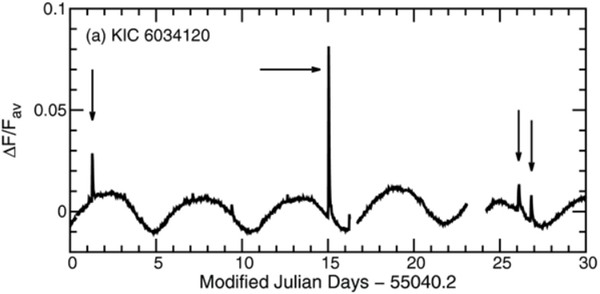The Sun is an active star. Even at its most quiet, its surface trembles and shimmers as if it can barely hold in the contents of its hot belly. And when it finally releases that frightening power — launching a solar flare or a coronal mass ejection (CME) into interplanetary space — we can only hope the blast misses Earth.
If it doesn’t miss, Earth bears the brunt of the Sun’s fury. This can cause our planet to experience strong geomagnetic storms, which may disrupt navigational systems, overload power grids, and knock out satellites in orbit. The economic costs of a powerful and well-aimed solar explosion could add up to billions of dollars per day.
Preventing potential disaster brought upon us by our closest star will be difficult, to say the least. To stand a chance, we have to learn more about solar activity. However, the most powerful events are also very rare. To understand the extreme end of solar behavior, we need to observe the Sun on long timescales — and peer into its distant past.
Centuries of data
The first evidence of solar activity that humans noticed was sunspots, with the earliest known records dating to 28 B.C. in ancient China. Detailed telescopic observations of sunspots go back to the 1600s and represent perhaps the longest-running series of direct observations of any natural phenomenon. Counting sunspots revealed that their numbers change periodically over time in an 11-year cycle — from virtually zero to tens or even hundreds of spots dotting the Sun’s face at once.
Additional observations from the ground and, in the modern era, space-based observatories linked sunspots to magnetic fields. The flow of hot plasma within the Sun generates electric currents, which in turn generate magnetic fields. Solar rotation stretches and twists these fields around the Sun. Sunspots mark the regions where magnetic field lines penetrate the surface; the pressure they exert cools the gas, making them appear not as bright as their surroundings.
Sometimes the entangled magnetic field lines snap, releasing an enormous amount of energy. The emerging flare shoots particles and high-energy radiation into space. As the magnetic loops reconnect, they may leave the surface, carrying plasma with them into space as a CME.
Scientists understand the basic physics of explosive solar phenomena. But the details remain elusive. “What makes it unstable, where does it happen, can we have a certain lead time to predict it?” are all questions researchers are trying to answer, says Astrid Veronig, a solar physicist at the University of Graz in Austria.
To answer them, historical data can be just as important as fresh observations.
Drilling down into solar history
The first flare ever directly detected was also one of the strongest. The 1859 Carrington event wreaked havoc on telegraph networks and led to auroras which, in the northern hemisphere, were visible as far south as the Caribbean. A similarly strong event from 2012 fortunately missed Earth. But such events, while threatening, pale in comparison to superflares on other stars, whose energy outputs can be 10 to 10,000 times stronger. As far as flaring is concerned, the Sun has long been considered a relatively clement star.
And then, in 2012, scientists discovered that the Sun produced a superflare in A.D. 775 — a revelation that showed the Sun is capable of much more than previously believed.
The vestiges of such violent solar events lie hidden in the rings of ancient trees and deep under the layers of ice at Earth’s polar caps. When a stream of energetic particles, accelerated by a flare, barges into the Earth’s atmosphere, it sets off a chain of reactions. The collisions between the particles and air molecules create radioactive isotopes (elements with the same number of protons but a different number of neutrons) that eventually settle down all over the planet. The isotopes get absorbed into tree rings, where scientists can search for spikes in isotope concentrations. And because each tree ring corresponds to one year of growth, they can very precisely determine the year each spike occurred.
“Old trees are very valuable, and we collaborate with dendrochronologists to use old trees,” says Fusa Miyake of Nagoya University in Japan, who led the research that reported the A.D. 775 superflare. An important dating agent is carbon-14, an isotope with six protons and eight neutrons in its nucleus. Ice cores store beryllium-10 and chlorine-36 isotopes, which provide similar albeit slightly less accurate dating information.
To date, scientists have found a handful of solar superflare candidates, and there might be more of them buried in the data. “There is the possibility that the strongest event has not been found because there are many periods which have not been surveyed,” says Miyake.
However, these dating techniques are limited to relatively recent samples. The lifetime of carbon-14 allows for dating up to 50,000 years in the past, and tree samples as old as 42,000 years exist. But scientists have only been able to dendrochronologically date samples within the last 12,000 years, a geological period known as the Holocene.
The Moon’s million-year memory
That earthly limitation raises a question: Is the solar activity in the Holocene special? To answer that, scientists have to turn to a completely different planetary body: the Moon.
“Lunar rock or any other rock unprotected by atmosphere is a rough spectrometer,” says Ilya Usoskin of the University of Oulu in Finland. When a cosmic ray hits a rock, it induces a nuclear reaction and creates isotopes, which can be analyzed in a lab. Some of these cosmic rays are charged particles from the Sun; others (which tend to be higher in energy) come from sources farther out in the Milky Way, beyond our solar system.
The Apollo missions returned with many lunar rock samples — including a deep, 8-foot-long (2.4 meters) drill core collected on Apollo 15. This core is significant because galactic cosmic rays, which are more abundant at high energies than solar particles, plant isotopes deep into the rocks. In contrast, solar cosmic rays leave their imprints only in shallower rocks. The Apollo 15 deep core allows scientists to understand the contributions of galactic cosmic rays — meaning they can then single out the contributions of solar particles in the shallower layers to better understand the Sun’s behavior over time.
Scientists can only extract information about a bombardment of particles averaged over several million years. Nevertheless, the method provides valuable insights. For example, the isotope concentrations suggest that, on average, solar activity has remained relatively constant over the past several million years. Moreover, the number of superflares inferred from the lunar rocks agrees well with the observed number of events marked by isotope deposits in tree rings.
In other words, we shouldn’t expect the Sun’s activity to tail off anytime soon.
Solar adolescence
Sometimes, however, we need to gaze toward distant stars to learn about the Sun’s distant past. “Other stars tell us how the Sun behaved in time,” says Veronig. For example, younger stars typically rotate faster. And because the rotation of a star drives its magnetic dynamo, a faster rotation produces stronger magnetic fields, leading to stronger flaring events. Scientists thus believe that the Sun was much more active in its younger days.
The young Sun’s activity may not be so relevant for us today, but it was very important for our earliest, prehistoric predecessors. “The history of the Sun is linked to the history of the planets because strong flares and CMEs interact with the planets,” says Veronig. For example, having a few flares may help build up complex molecules like RNA and DNA from simpler building blocks. But too many intense flares can strip entire atmospheres, rendering a planet uninhabitable.
Our observations tell us that superflares are not uncommon on Sunlike stars. But to learn more about activity on other stars, researchers would also like to study their fainter CMEs, which cannot be observed directly. Veronig and her colleagues recently developed a technique to detect CMEs on other stars by searching for the characteristic dimming at ultraviolet and X-ray wavelengths that follows a CME event. The team found strong evidence of CME explosions on several stars, including Proxima Centauri, the closest star to Earth.
Another way is to measure stellar activity is to infer it from the presence and sizes of starspots. This can be done by measuring the brightness of a star over time as it rotates; astronomers can then identify dips in brightness that correspond to groups of starspots rotating in and out of view. More recently, some stars have been resolved and imaged using interferometry, allowing astronomers to see their starspots directly.
At the moment, we cannot predict when a flare will occur on the Sun, nor whether a launched CME might pose a threat. But our studies of the solar past have already taught us an important lesson. Space agencies and governments used to ignore the danger of superflares, whose rate had been predicted to be less frequent than one per million years. But now it seems that a solar superflare can occur once per millennium, maybe even as frequent as once per 500 years. “It should be taken into consideration,” says Usoskin. “Because once per 500 years is not that rare.”

